|
The
Last Salute: Civil and Military Funeral, 1921-1969
CHAPTER XXIV
General of the Army
Douglas MacArthur
State Funeral
5-11 April 1964
General of the Army Douglas MacArthur died on 5 April 1964 in Walter
Reed General Hospital at the age of eighty-four. Earlier President Kennedy
had authorized a State Funeral, and President Johnson confirmed the
directive when he ordered that General MacArthur be buried "with
all the honor a grateful nation can bestow on a departed hero."
Plans for the funeral, which had been made some time before in consultation
with the general himself, specified that the ceremonies should occupy
seven days instead of the four days prescribed in the plan of 1958 for
a State Funeral. In accordance with the wishes of the general he was
to be buried in Norfolk, Virginia, rather than in Arlington National
Cemetery and his body was to lie in the 7th Regiment Armory in New York
City and in the MacArthur Memorial in Norfolk as well as in the Capitol
in Washington.
Maj. Gen. Philip C. Wehle, commander of the Military District of Washington,
was responsible for arranging and conducting ceremonies taking place
in Washington and for coordinating all funeral ceremonies. From his
resources in the Washington area he was to provide whatever assistance
and support were necessary in New York City and Norfolk. The Commanding
General, First U.S. Army, Lt. Gen. Garrison H. Davidson, was in charge
of ceremonies in New York City, and the Commanding General, US Continental
Army Command, General Hugh P. Harris, had charge of ceremonies in Norfolk.
In each command area, a center was established from which funeral operations,
administrative and ceremonial, were controlled.
When he was notified of General MacArthur's death, General Wehle, in
accordance with plans, went to Walter Reed General Hospital, accompanied
by John C. Metzler, superintendent of Arlington National Cemetery, who
provided a casket, a flag, and a hearse. With him also were the body
bearers-one officer, one noncommissioned officer, and three enlisted
men from the 3d Infantry and Armed Forces Police in two escort vehicles.
Shortly after General Wehle reached the hospital, the Army officer assigned
as military aide to the next of kin, Col. Neil Robinson, arrived to
accompany the cortege to New York City.
The cortege left Washington about 1730 on 5 April. An Armed Forces Police
[216]
sedan led the way, followed by a limousine carrying General Wehle and
Mr. Metzler; the hearse; a limousine and two sedans with members of the
family, the personal staff, and Colonel Robinson; a station wagon bearing
the casket detail; and an Armed Forces Police sedan bringing up the rear.
For use in case of mechanical difficulty with the hearse, a second hearse
trailed the cortege by twenty minutes.
In each state local police escorted the cortege as it passed through.
During a scheduled halt on the New Jersey Turnpike, Mrs. MacArthur was
upset by the sight of the hearse being refueled before a crowd of curious
onlookers; otherwise, the trip was made without mishap. Reaching New York
City about 2330, the cortege separated, the hearse and escort proceeding
to the Universal Funeral Parlor and the family cars directly to the MacArthur
apartment in the Waldorf Towers. General Davidson, the First Army commander,
was present at the funeral establishment to meet the hearse and to relieve
General Wehle as escort commander.
At 1700, before the cortege left Washington, the Military District of
Washington had dispatched a joint service guard of honor, made up of four
officers and thirteen enlisted men, and a joint service casket detail
to New York from Andrews Air Force Base. These troops arrived at the Universal
Funeral Parlor at 2100. The 3d Infantry sent a caisson detail and a caparisoned
horse and a handler from Fort Myer, Virginia, at 2230; they reached New
York at 0530 on 6 April. All were to participate in the ceremonies, those
in the guard of honor joining other members of the guard furnished by
First Army.
General MacArthur's body was prepared for burial at the funeral establishment
under the direction of Capt. G. R. Rubin, the First Army mortuary officer.
The general was dressed in a tropical worsted uniform adorned only with
the US and grade insignia. The casket was draped with a flag and, with
the top cover open, was placed in the main chapel of the funeral establishment
at 0500 on 6 April. The guard of honor posted a relief at the bier at
0800 and maintained a vigil until 0200 on the 7th. The public was not
admitted to the chapel.
At 0900 on the 6th, Maj. Gen. Courtney Whitney, long-time aide and close
friend of General MacArthur's, viewed the body and made the decision to
leave the casket open during subsequent periods of lying in state. Later
in the morning General Whitney conferred in his office with Colonel Robinson
and Brig. Gen. Howard McCrum Snyder, Jr., the Chief of Staff, First Army.
General Snyder explained the details of events to take place on 7 April
and together the three officers decided that the family group-the immediate
family, close friends, and aideswould number twenty-six during the
ceremonies in New York.
The guard of honor meanwhile was having difficulty. By 1230 on 6 April
the sixteen officers and 126 enlisted men, including a seventeen-man detail
furnished by the Military District of Washington, had arrived in New York
and had been billeted at the 7th Regiment Armory on Park Avenue. First
the billeting arrangement proved inadequate for the number of men. Second,
and of more consequence, the food, handled by a caterer, was unsanitary.
After fifteen of the guard
[217]
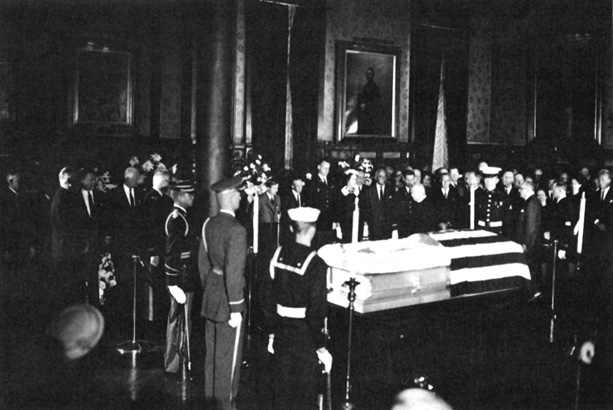
PRIVATE MEMORIAL SERVICE IN 7TH REGIMENT ARMORY
detail became ill with food poisoning and required medical treatment,
a change was made to obtain food service from a First Army mess.
At 0400 on 7 April General MacArthur's body was moved to the 7th Regiment
Armory, where it was to lie in the Clark Room throughout the day. A
relief of the guard of honor was posted immediately after the casket
was placed on the bier. Later in the morning at 0915, Mrs. MacArthur
and the family group arrived at the armory for a private interfaith
memorial service. Waiting to greet the widow in the family room adjoining
the Clark Room, and then to attend the memorial service, were several
dignitaries, including New York Governor Nelson A. Rockefeller, New
York City Mayor Robert F. Wagner, and former New York Governor Thomas
E. Dewey, and a group of diplomats.
A ten-minute memorial service was conducted by clergymen of three faiths:
Cardinal Francis Spellman; the Right Reverend H. W. B. Donegan, Episcopal
bishop of New York City; the Reverend T. J. Finlay, pastor of St. Bartholomew's
Episcopal Church, of which MacArthur was a member; and Rabbi Max Schenk,
president of the New York Board of Rabbis. After the service Colonel
Robinson,
[218]
the military aide to the next of kin, escorted the group back to the
family room, where Mrs. MacArthur received the condolences of those
who had attended. No other ceremonies were held on 7 April. At approximately
1000 the armory was opened to the public and remained open until 2315.
Some 35,000 people passed by the bier.
Early on 8 April, a rainy day, troops assembled by the First Army began
to form three security cordons: one at the armory, another at Pennsylvania
Station, and a third at the station's loading platform. The troops for
the cordons came from all five uniformed services: 6 officers and 300
enlisted men from the Army; 3 officers and 150 enlisted men from the
Marine Corps; 1 officer and 50 enlisted men from the Navy; 2 officers
and 75 enlisted men from the Air Force; and 1 officer and 25 enlisted
men from the Coast Guard. In addition, the Corps of Cadets from the
US Military Academy, less one battalion, formed in a line of battalions
on Seventh Avenue opposite and facing Pennsylvania Station.
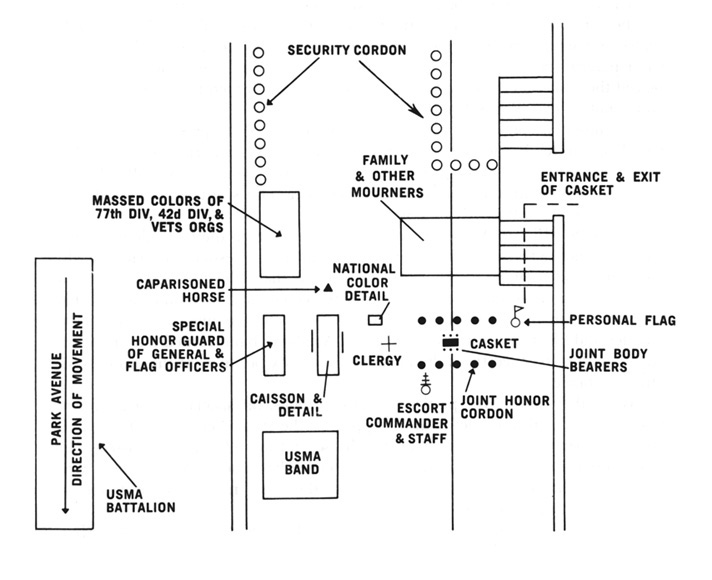
Diagram 63. Departure ceremony, 7th Regiment Armory, New York City.
[219]
Troops that would march in the procession assembled at the armory about
0715. The military escort troops included the escort commander, General
Davidson, and his staff, the troop commander and his staff, the
US Military Academy Band, and a battalion of West Point cadets. To march
with the cortege were a special honor guard of general and flag officers
from all five services; a national color detail and joint body bearer
team provided by the Military District of Washington; and a caisson,
a caisson detail, and a caparisoned horse with an attendant from the
3d Infantry. Cadet Captain H. P. Kindleberger of the US Military Academy
was the personal flag bearer. Also in the cortege were the massed colors
of veterans' organizations, of the 42d Infantry (Rainbow) Division of
the New York Army National Guard, and of the 77th Infantry Division
of the Army Reserve.
At 0745 members of the family group began to assemble in the family
room of the armory. Fifteen minutes later, when they had taken their
positions outside, General MacArthur's casket was borne from the armory
in procession, the casket preceded by the national color detail and
the clergy and followed by the personal flag bearer. Outside the armory,
the procession came to a halt, the band sounded ruffles and flourishes,
and troop units presented arms. (Diagram 63) After the band played
one chorus of "The Corps," a West Point song, the body bearers
placed the casket on the caisson. The procession then formed for the
march of two and a half miles to Pennsylvania Station.
Mounted city police led and brought up the rear of the procession. (Diagram
64) The rain fell harder as the column left the armory at Park Avenue
and 66th Street, followed Park Avenue to 57th Street, turned west across
Fifth Avenue, and then went south on Broadway. After crossing Times
Square, it moved along Seventh Avenue to Pennsylvania Station.
The US Military Academy cadets forming a line on the east side of Seventh
Avenue opposite the station stood at attention as the procession approached.
After the police and military escort passed in front of the cadet formation,
the police continued to march until they were out of the ceremonial
area and the marching cadet battalion moved to the far flank of the
cadets in line. The escort commander and his staff and the US Military
Academy Band turned out of the procession as they reached the railroad
station and took positions at the station's 31st Street entrance.
When they had moved past the cadet battalions, the special honor guard,
national color detail, and clergy also stopped at the station entrance.
The caisson and body bearers, personal flag bearer, horse and attendant,
and massed colors formation halted at the near flank of the cadet line
and remained there while members of the family group descended from
their cars in front of the station and took positions at the entrance
(Diagram 65)
After all participants were in their places, the US Military Academy
Band sounded ruffles and flourishes and played the "General's March."
When the
[220]
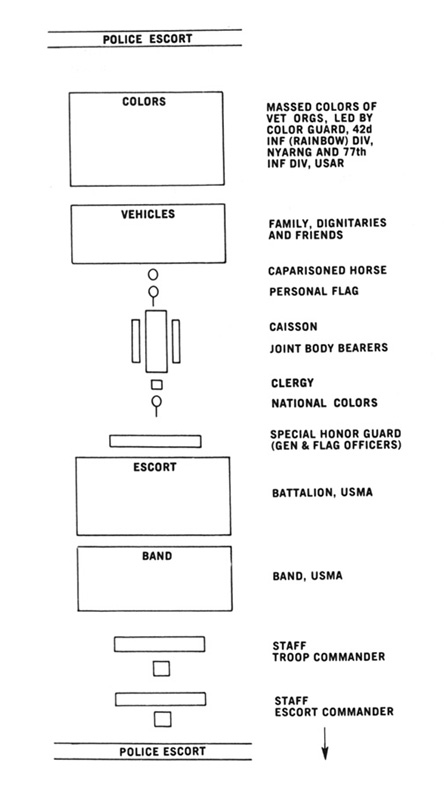
Diagram 64. Order of march of funeral procession, New
York City.
[221]

Diagram 65. Formation at Pennsylvania Station, New York
City.
[222]
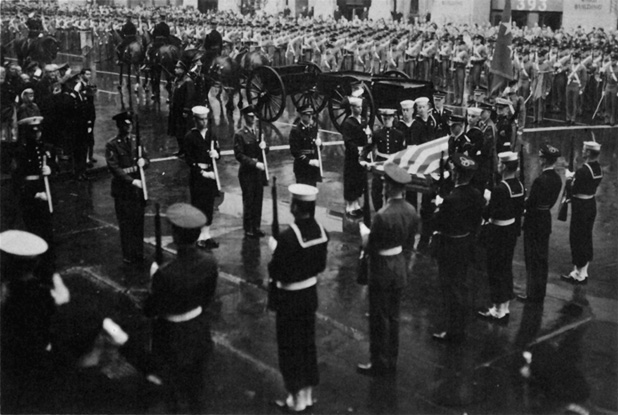
CASKET IS CARRIED THROUGH HONOR CORDON AT PENNSYLVANIA
STATION
band began a hymn, the caisson and body bearers, personal flag bearer,
and caparisoned horse with its attendant trooped the line of cadets,
moving to the far flank of the formation and returning to the 31st Street
entrance of the station. The body bearers then transferred General MacArthur's
casket to a hearse at the entrance. The family group entered the station
and walked through the concourse to the funeral train, which was below
street level. The hearse, accompanied by the escort commander, special
honor guard, body bearers, and personal flag bearer, moved via the 31st
Street taxi ramp to an elevator that lowered the casket to the loading
platform below. The body bearers then placed the casket in the funeral
car, where they were joined by the personal flag bearer. The family
group entered the car ahead. (Diagram 66) Scores of floral tributes
were placed in the funeral car, whose side doors were left open so that
the flag-draped casket could be seen from outside. The train left New
York for Washington at 0935.
Most of the troops who had participated in the ceremonies then returned
to their home stations. The members of the guard of honor furnished
by the Military District of Washington, however, left at 1030 on 8 April
for Norfolk, Virginia, where they would participate in further ceremonies
beginning on the 9th. At 1130
[223]
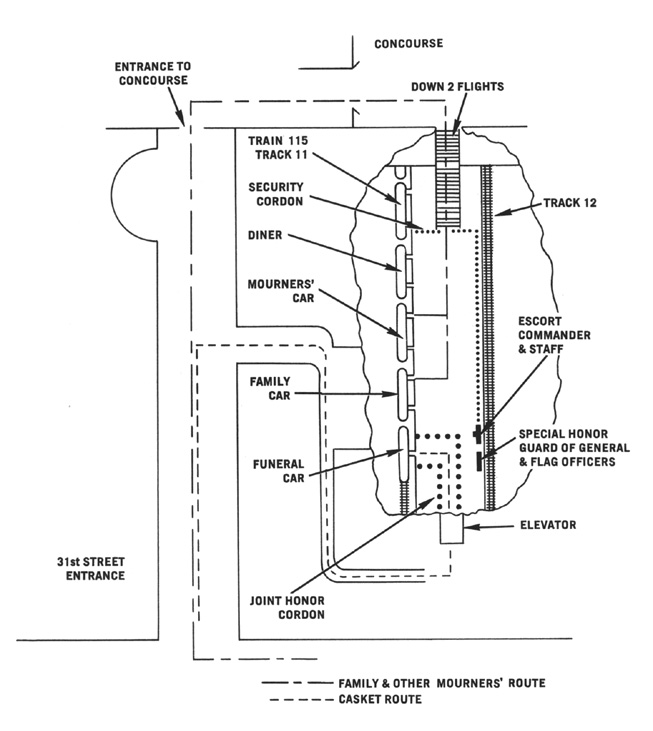
Diagram 66. Approach to funeral train, Pennsylvania
Station, New York City.
the caisson detail and the caparisoned horse with an attendant also
left for Norfolk.
The funeral train slowed down at several points where crowds had gathered
and made a few stops. On these occasions, Mrs. MacArthur came to the
door to acknowledge the tribute paid the general. During the stop at
Trenton, New Jer-
[224]
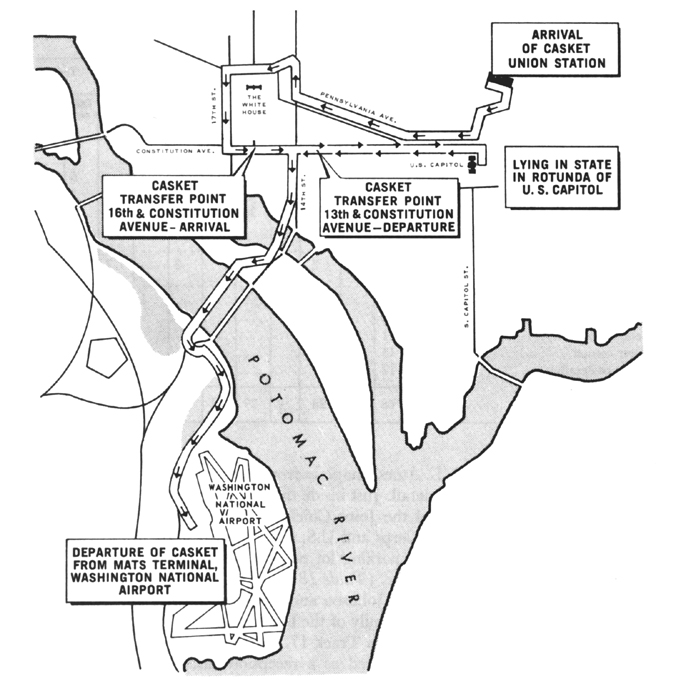
Diagram 67. Route of march and ceremonial sites, Washington,
D.C.
sey, the governor came aboard to greet Mrs. MacArthur. It was 1320
when the train reached Washington and entered Union Station on Track
17. (Diagram 67)
Ceremonial troops arranged for by the Military District of Washington
were on hand at Union Station. A joint service honor cordon lined the
platform and station concourse; on the platform at Track 17 were General
Wehle, the escort
[225]
TABLE 18-TROOP LIST, ARRIVAL CEREMONY AT UNION
STATION,
WASHINGTON, DC, FOR GENERAL OF THE ARMY DOUGLAS MACARTHUR
|
Duty
|
US Army
|
US Marine
Corps
|
US Navy
|
US Air
Force
|
US Coast
Guard
|
Total
|
|
Offi-
cers
|
En-
listed
Men
|
Offi-
cers
|
En-
listed
Men
|
Offi-
cers
|
En-
listed
Men
|
Offi-
cers
|
En-
listed
Men
|
Offi-
cers
|
En-
listed
Men
|
Offi-
cers
|
En-
listed
Men
|
| Escort commander and staff |
1
|
|
|
|
|
|
|
|
|
|
1
|
|
| Special honor guard |
2
|
|
1
|
|
1
|
|
1
|
|
1
|
|
6
|
|
| Commander of troops and staff |
1
|
|
|
|
|
|
|
|
|
|
1
|
|
| Honor cordon |
1
|
26
|
|
26
|
|
26
|
|
26
|
|
26
|
1
|
130
|
| National color detail |
|
1
|
|
|
|
1
|
|
1
|
|
|
|
3
|
| Clergy |
1
|
|
|
|
|
|
|
|
|
|
1
|
|
| Body bearers |
1
|
2
|
|
2
|
|
2
|
|
2
|
|
2
|
1
|
10
|
| Personal flag bearer(cadet) |
|
1
|
|
|
|
|
|
|
|
|
|
1
|
| Band |
|
|
|
|
|
|
|
|
1
|
33
|
1
|
33
|
| Site control |
3
|
2
|
|
|
|
|
|
|
|
|
3
|
2
|
| Security cordon |
1
|
11
|
|
|
|
|
|
|
|
|
1
|
11
|
| Press cordon |
1
|
13
|
|
|
|
|
|
|
|
|
1
|
13
|
| Baggage detail |
|
12
|
|
|
|
|
|
|
|
|
|
12
|
| Total |
12
|
68
|
1
|
28
|
1
|
29
|
1
|
29
|
2
|
61
|
17
|
215
|
commander, Col. Kenneth L. Ames, chaplain from the Military District
of Washington, and a national color detail. Just inside the east entrance
on the concourse, the chairman and members of the joint Chiefs of Staff
together with the commandants of the US Marine Corps and US Coast Guard
stood in formation as the special honor guard. In the parking lot outside
the east entrance, the Coast Guard Band waited near the hearse. (Table
18)
President and Mrs. Lyndon B. Johnson and Attorney General and Mrs. Robert
F. Kennedy, representing the family of the late President Kennedy, were
present when the funeral train arrived on Track 17. The Kennedys boarded
first, entering a diner that had been prepared as a reception car. President
and Mrs. Johnson then went aboard and a few minutes later escorted Mrs.
MacArthur from the train. With the rest of the family group following,
they led the way through the honor cordon, which stood at attention,
to the concourse just inside the east entrance.
The body bearers meanwhile removed General MacArthur's casket from the
funeral car and placed it on a movable bier. After the family was in
position, the casket, preceded by General Wehle, the national color
detail, and the chaplain and followed by the personal flag bearer, was
taken through the concourse as far as the east entrance. As the procession
moved, the members of the honor cordon presented arms in ripples.
[226]
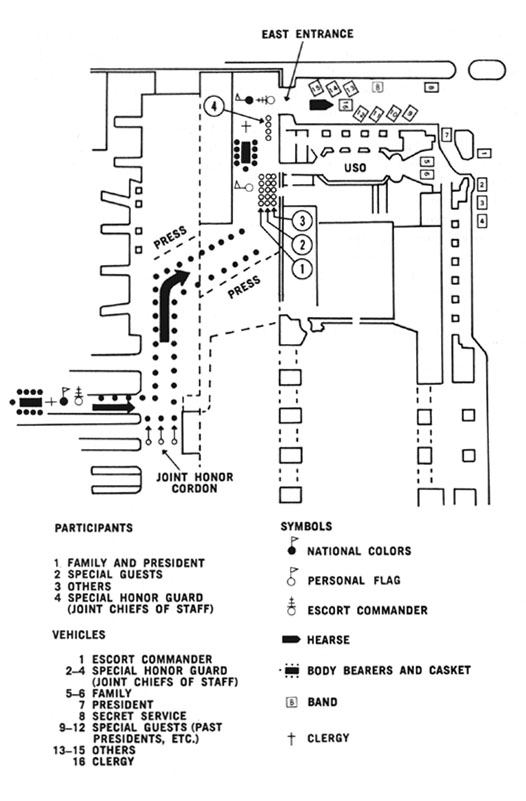
Diagram 68. Arrival ceremony, Union Station, Washington,
DC
[227]
When the procession came to a stop at the east entrance, the Coast
Guard Band played ruffles and flourishes, the "General's March,"
and "Lead Kindly Light." As the hymn began, the body bearers
lifted the casket from the bier and the procession made its way to the
hearse. After the casket had been placed in the hearse, the band ceased
playing and the honor cordon came to order arms. The family and others
then entered automobiles and joined the procession that would circle
the White House and come to an end at the Capitol. (Diagram 68)
The cortege left Union Station shortly after 1400, led by local police,
who were followed by the escort commander, the special honor guard in
three vehicles, the clergy, and the hearse. Behind the hearse were two
cars bearing the family, two cars carrying the President and his party,
seven cars with other mourners, and police bringing up the rear. The
cortege moved down Delaware Avenue, turned right onto Constitution Avenue,
and followed Constitution onto Pennsylvania Avenue. After circling the
White House via Pennsylvania Avenue, 14th Street, and New York Avenue,
it turned left at 17th Street and left again onto Constitution Avenue,
proceeding east to the intersection of Constitution and 16th Street
where the general's casket was to be transferred to a caisson. (See
Diagram 67.) While military escort units waited ahead on Constitution
Avenue to lead the procession the remaining distance to the Capitol,
cars containing dignitaries stood ready to join the cortege between
17th and 18th Streets.
TABLE 19-TROOP LIST, CASKET TRANSFER CEREMONY,
WASHINGTON, DC, FOR GENERAL OF THE ARMY DOUGLAS MACARTHUR
|
Duty
|
US Army
|
US Marine
Corps
|
US Navy
|
US Air
Force
|
US Coast
Guard
|
Total
|
|
Offi-
cers
|
En-
listed
Men
|
Offi-
cers
|
En-
listed
Men
|
Offi-
cers
|
En-
listed
Men
|
Offi-
cers
|
En-
listed
Men
|
Offi-
cers
|
En-
listed
Men
|
Offi-
cers
|
En-
listed
Men
|
| Escort commander and staff |
1
|
|
|
|
|
|
|
|
|
|
1
|
|
| Special honor guard |
2
|
|
1
|
|
1
|
|
1
|
|
1
|
|
6
|
|
| National color detail |
|
1
|
|
1
|
|
1
|
|
|
|
|
|
3
|
| Clergy |
1
|
|
|
|
|
|
|
|
|
|
1
|
|
| Body bearers |
1
|
2
|
|
2
|
|
2
|
|
2
|
|
2
|
1
|
10
|
| Personal flag bearer (cadet) |
|
1
|
|
|
|
|
|
|
|
|
|
1
|
| Caisson detail |
|
5
|
|
|
|
|
|
|
|
|
|
5
|
| Site control |
2
|
6
|
|
|
|
|
|
|
|
|
2
|
6
|
| Security cordon |
5
|
285
|
|
|
|
|
|
|
|
|
5
|
285
|
| Guides |
|
2
|
|
2
|
|
2
|
|
2
|
|
|
|
8
|
| Traffic guides |
|
1
|
|
1
|
|
1
|
|
1
|
|
|
|
4
|
| Parking detail |
|
2
|
|
2
|
|
2
|
|
2
|
|
|
|
8
|
| Communications |
|
5
|
|
|
|
|
|
|
|
|
|
5
|
| Information desk |
|
1
|
|
|
|
|
|
|
|
|
|
1
|
| Total |
12
|
311
|
1
|
8
|
1
|
8
|
1
|
7
|
1
|
2
|
16
|
336
|
[228]
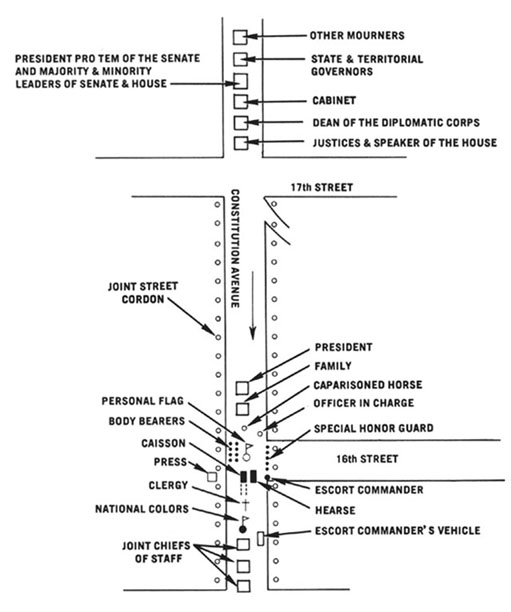
Diagram 69. Formation for the casket transfer ceremony,
Washington, DC
When the cortege reached 16th Street the hearse halted to the left of
and parallel to the caisson, which stood in the middle of the intersection
of Constitution Avenue and 16th Street. The escort commander, special
honor guard, and clergy left their vehicles and took their positions
for the transfer ceremony. All others in the cortege remained in their
cars. (Diagram 69) At a signal from the site control
[229]
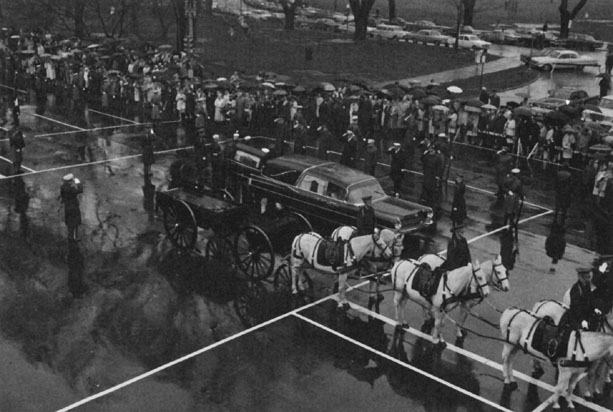
CASKET IS TRANSFERRED TO CAISSON ON CONSTITUTION AVENUE,
Washington, DC
officer, the body bearers (a different team from that which had served
at Union Station) removed the casket from the hearse and placed it on
the caisson; as they did so the troops saluted. Chaplain Ames then took
his place in front of the caisson, which he would precede on foot, and
members of the special honor guard returned to their automobiles. The
escort commander was driven ill his car to the head of the full procession.
(Table 19)
Behind a police escort, the escort commander and the commander of troops
and his joint service staff of five led the military escort troops,
which were organized into three march units. The commander of the first
unit was an Army field grade officer with a joint service staff of five;
his troops included the Army Band, one officer and eighty-two enlisted
men; a company, four officers and eighty-five enlisted men, from each
of the four service academies; a company, four officers and eighty-five
enlisted men, each from the active Army, Marine Corps, Navy, Air Force,
and Coast Guard; and a composite company of servicewomen, five officers
and seventy-seven enlisted women.
[230]
The second march unit was led by an Army National Guard field grade officer
and a staff composed of a field grade officer each from the Army Reserve,
Marine Corps Reserve, Navy Reserve, Air National Guard, and Coast Guard
Re serve. In this unit were the Marine Band, one officer and eighty-two
enlisted men, and a company, four officers and eighty-five enlisted men,
each from the Army National Guard, Army Reserve, Marine Corps Reserve,
Navy Reserve, Air National Guard, Air Force Reserve, and Coast Guard Reserve.
The third march unit was composed of the Air Force Band, one officer and
eighty-two enlisted men, and the commanders, or their representatives,
of twenty-seven veterans' organizations. Six of the delegates acted as
the march unit commander and staff. Although it was not the usual procedure,
the special honor guard also marched to the Capitol as part of the third
unit.
With the addition of dignitaries who joined at the transfer point, the
cortege now included the national color detail, clergy, caisson, personal
flag bearer, caparisoned horse, MacArthur family group, President and
his party, Speaker of the House of Representatives, justices of the Supreme
Court, dean of the diplomatic corps, cabinet officials, president protempore
of the Senate with the Senate and House majority and minority leaders,
state and territorial governors, and other mourners. A police escort brought
up the rear of the procession. (Diagram 70).
From the casket transfer point to the East Plaza of the Capitol a joint
service street cordon lined both sides of Constitution Avenue. (Table
20) As the procession moved, the members of the street cordon presented
arms individually when the national color detail approached and ordered
arms after the President had passed.
Just before they reached the Capitol most of the escort units, including
the delegations from veterans' organizations, turned left on Louisiana
Avenue and proceeded to dismissal points. Only the Army Band and the right
flank platoon of each company of the Army, Marine Corps, Navy, Air Force,
and Coast Guard of the first march unit moved into formation on the East
Plaza.
The escort commander, special honor guard, national color detail, clergy,
caisson, personal flag bearer, caparisoned horse and his handler, family
group, and President Johnson and his party turned out of the line of march
as they reached the Capitol driveway entrance opposite New Jersey Avenue.
This group waited on the driveway until the escort units reached positions
on the plaza and other dignitaries in the cortege got out of their cars
at the east steps of the Capitol and entered the rotunda. General Wehle
then led those waiting on the drive to their ceremonial positions on the
plaza. (Diagram 71)
Besides the troops arriving with the procession, those participating in
the ceremony included a joint service honor cordon, which lined the east
steps, and the 3d Infantry saluting battery, in position on the grounds
near Louisiana Avenue and D Street. Inside the Capitol waited a joint
service guard of honor, which would
[231]
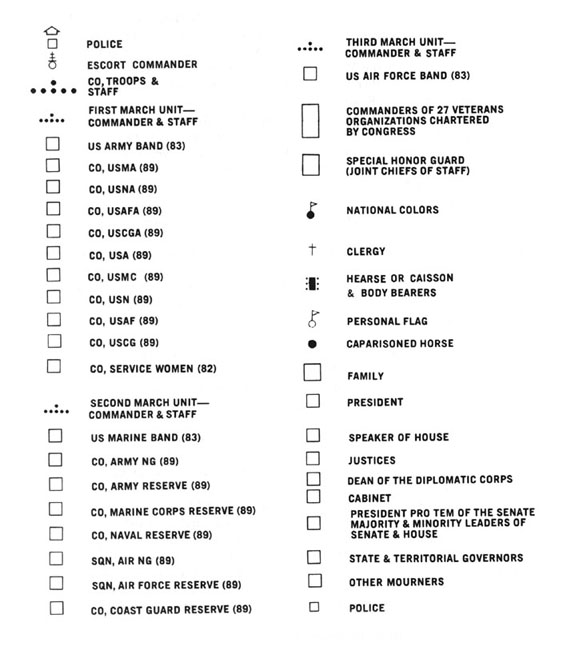
Diagram 70. Order of march, full procession, Washington,
DC
[232]
TABLE 20-TROOP LIST, MAIN PROCESSION IN WASHINGTON,
DC,
FOR GENERAL OF THE ARMY DOUGLAS MACARTHUR
|
Duty
|
US Army
|
US Marine
Corps
|
US Navy
|
US Air
Force
|
US Coast
Guard
|
Total
|
|
Offi-
cers
|
En-
listed
Men
|
Offi-
cers
|
En-
listed
Men
|
Offi-
cers
|
En-
listed
Men
|
Offi-
cers
|
En-
listed
Men
|
Offi-
cers
|
En-
listed
Men
|
Offi-
cers
|
En-
listed
Men
|
| Escort commander and staff |
1
|
|
|
|
|
|
|
|
|
|
1
|
|
| Special honor guard |
2
|
|
1
|
|
1
|
|
1
|
|
1
|
|
6
|
|
| Commander of troops and staff |
2
|
|
1
|
|
1
|
|
1
|
|
1
|
|
6
|
|
| National color detail |
|
1
|
|
1
|
|
1
|
|
|
|
|
|
3
|
| Clergy |
1
|
|
|
|
|
|
|
|
|
|
1
|
|
| Body bearers |
|
2
|
|
2
|
|
2
|
|
2
|
|
2
|
|
10
|
| Personal flag bearer (cadet) |
|
1
|
|
|
|
|
|
|
|
|
|
1
|
| Caisson detail |
|
5
|
|
|
|
|
|
|
|
|
|
5
|
| Band |
1
|
82
|
1
|
82
|
|
|
1
|
82
|
|
|
3
|
246
|
| Military Escort |
|
|
|
|
|
|
|
|
|
|
|
|
| Active |
6
|
85
|
5
|
85
|
5
|
85
|
5
|
85
|
5
|
85
|
26
|
425
|
| Cadet |
4
|
85
|
|
|
4
|
85
|
4
|
85
|
4
|
85
|
16
|
340
|
| Servicewomen |
2
|
20
|
1
|
19
|
1
|
19
|
1
|
19
|
|
|
5
|
77
|
| National Guard |
5
|
85
|
|
|
|
|
4
|
85
|
|
|
9
|
170
|
| Reserve |
5
|
85
|
5
|
85
|
5
|
85
|
5
|
85
|
5
|
85
|
25
|
425
|
| Street cordon |
|
|
3
|
217
|
3
|
217
|
3
|
217
|
|
|
9
|
651
|
| Site control |
5
|
6
|
|
5
|
|
5
|
1
|
5
|
|
|
6
|
21
|
| Total |
34
|
457
|
17
|
496
|
20
|
499
|
26
|
665
|
16
|
257
|
113
|
2,374
|
maintain a vigil at the bier during the lying in state period. (Table
21)
When all participants were in position, the troop formations presented
arms, the Army Band played ruffles and flourishes and the "General's
March," and the battery fired a 19-gun salute. At the last round
of the salute the band began the hymn "God of Our Fathers,"
and the body bearers took the casket from the caisson. General Wehle
then led the way up the steps into the rotunda, followed by the special
honor guard, national color detail, clergy, body bearers with the casket,
personal flag bearer, MacArthur family, and President Johnson and his
party.
When the procession entered the rotunda the national color detail, clergy,
body bearers with the casket, and personal flag bearer turned right
and, making a semicircle, proceeded to the center of the rotunda. The
others moved to positions along the outer edge of the circular room.
After the body bearers placed the casket on the Lincoln catafalque they
remained at their stations while the colors were posted and the color
bearers dismissed. The first relief of the guard of honor then came
into the rotunda through the west entrance and took post at the bier;
the body bearers left by the east entrance. (Diagram 72)
[233]
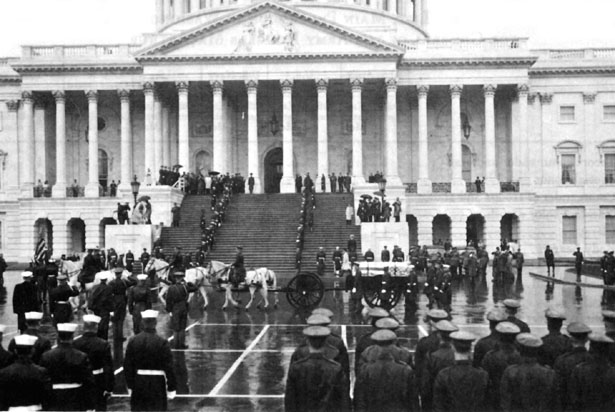
CAISSON HEARING THE CASKET ARRIVES AT THE CAPITOL, above.
BODY OF THE GENERAL LIES IN STATE IN THE ROTUNDA, below.
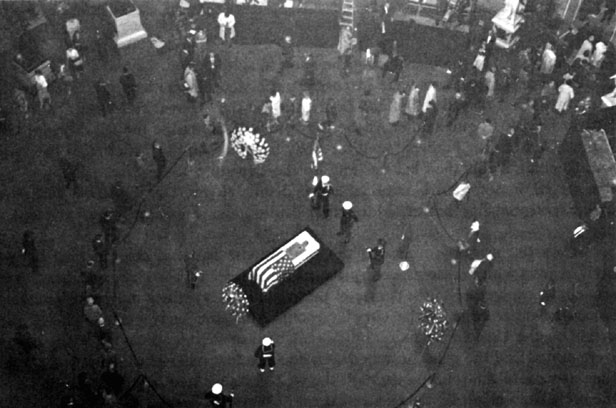
[234]
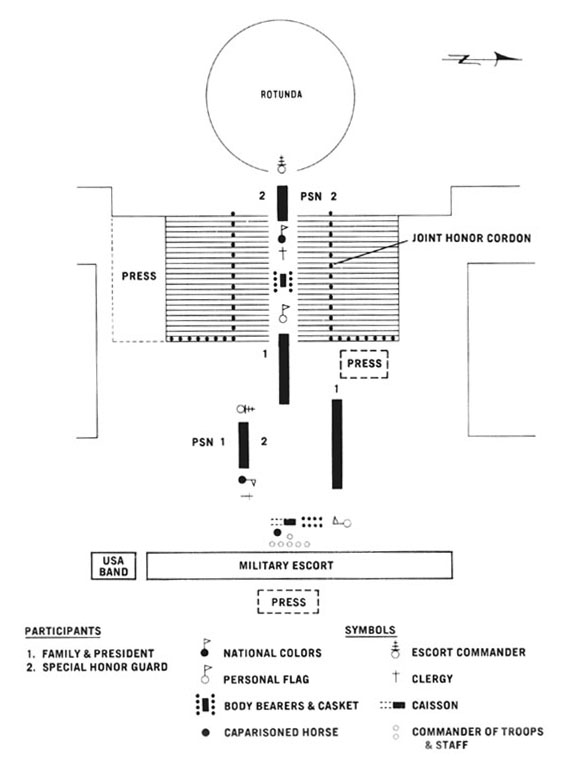
Diagram 71. Arrival ceremony at the Capitol.
[235]
TABLE 21-TROOP LIST, ARRIVAL CEREMONY AT THE US
CAPITOL
FOR GENERAL OF THE ARMY DOUGLAS MACARTHUR
|
Duty
|
US Army
|
US Marine Corps
|
US Navy
|
US Air Force
|
US Coast Guard
|
Total
|
|
Offi-
cers
|
En-
listed
Men
|
Offi-
cers
|
En-
listed
Men
|
Offi-
cers
|
En-
listed
Men
|
Offi-
cers
|
En-
listed
Men
|
Offi-
cers
|
En-
listed
Men
|
Offi-
cers
|
En-
listed
Men
|
| Escort commander and staff |
1
|
|
|
|
|
|
|
|
|
|
1
|
|
| Special honor guard |
2
|
|
1
|
|
1
|
|
1
|
|
1
|
|
6
|
|
| Commander of troops and staff |
2
|
|
1
|
|
1
|
|
1
|
|
1
|
|
6
|
|
| Honor cordon |
1
|
14
|
|
14
|
|
14
|
|
14
|
|
14
|
1
|
70
|
| National color detail |
|
1
|
|
1
|
|
1
|
|
|
|
|
|
3
|
| Clergy |
1
|
|
|
|
|
|
|
|
|
|
1
|
|
| Body bearers |
|
2
|
|
2
|
|
2
|
|
2
|
|
2
|
|
10
|
| Personal flag bearer (cadet) |
|
1
|
|
|
|
|
|
|
|
|
|
1
|
| Band |
1
|
82
|
|
|
|
|
|
|
|
|
1
|
82
|
| Military escort, active |
1
|
28
|
1
|
28
|
1
|
28
|
1
|
28
|
1
|
28
|
5
|
140
|
| Guard of honor |
3
|
13
|
1
|
11
|
1
|
11
|
1
|
11
|
1
|
11
|
7
|
57
|
| Saluting battery |
2
|
65
|
|
|
|
|
|
|
|
|
2
|
65
|
| Site control |
4
|
11
|
|
|
|
|
|
|
|
|
4
|
11
|
| Security cordon |
1
|
21
|
|
21
|
|
21
|
|
21
|
|
|
1
|
84
|
| Ushers |
|
8
|
|
|
|
|
|
|
|
|
|
8
|
| Floral detail |
3
|
9
|
|
|
|
|
|
|
|
|
3
|
9
|
| Traffic guides |
|
12
|
|
|
|
|
|
|
|
|
|
12
|
| Parking detail |
|
5
|
|
|
|
|
|
|
|
|
|
5
|
| Information desk |
|
5
|
|
|
|
|
|
|
|
|
|
5
|
| Total |
22
|
277
|
4
|
77
|
4
|
77
|
4
|
76
|
4
|
55
|
38
|
562
|
House Chaplain Bernard Braskamp and Senate Chaplain Frederick B. Harris
delivered eulogies. President Johnson then stepped forward and placed
a wreath at the base of the catafalque. Chaplain Ames pronounced the
benediction, after which the rotunda was cleared and the MacArthur
family retired to a private room in the Capitol.
Captain Rubin, the First Army mortuary officer, who was responsible
for the care of the general's body until 9 April, when he would be
relieved by John C. Metzler, superintendent of Arlington National
Cemetery, opened the casket, re draped the flag, and completed other
preparations for the lying in state period. Returning to the rotunda,
the family expressed satisfaction with the arrangements that had been
made and then left. At 1645 the rotunda was opened to the public.
When it was closed at 1230 on the 9th, an estimated 150,000 people
had filed by the bier.
On 9 April at 1300, a departure ceremony was held at the Capitol and
General MacArthur's body was escorted to Washington National Airport,
where he
[236]
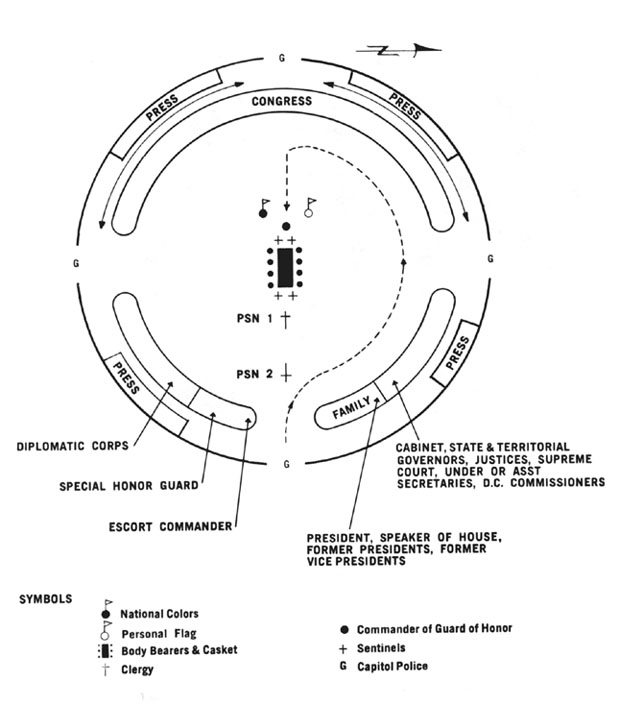
Diagram 72. Arrival ceremony in the rotunda.
was again honored. Before the ceremony at the Capitol began the escort
commander, General Wehle, the special honor guard (the chairman and
members of the joint Chiefs of Staff including the commandants of the
Marine Corps and Coast Guard), the Coast Guard Band, and a joint service
honor cordon took their positions on the East Plaza and steps. The caisson,
caparisoned horse and his handler, and automobiles for those accompanying
the cortege were also aligned on
[237]
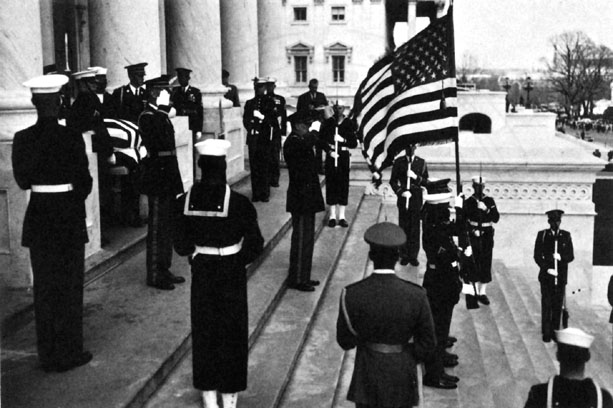
PROCESSION HALTS ON EAST CAPITOL STEPS, above.
Full procession turns onto Constitution Avenue, below.
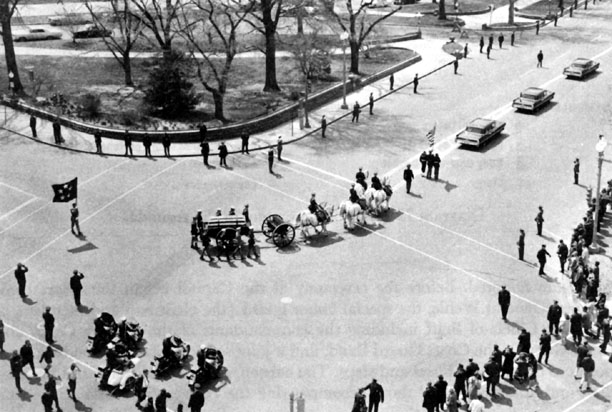
[238]
the plaza. Inside the Capitol waited the body bearers, national color
detail, personal flag bearer, and Colonel Ames, the chaplain from the
Military District of Washington. (Table 22)
At 1245 members of the MacArthur family arrived at the Capitol and went
into the rotunda to say a prayer. They then took their places on the
plaza. At 1300, after the guard of honor was dismissed from the vigil
at the bier, the body bearers took up the casket and carried it in procession,
led by the national color detail and clergy and followed by the personal
flag bearer. The procession left the rotunda through the east door;
when the national color detail appeared at the top of the steps, the
honor cordon presented arms. The procession halted when the body bearers
reached the top landing and the band sounded ruffles and flourishes.
As it began to play "Abide With Me," the procession moved
on to the caisson. After the casket was placed on the caisson, the band
ceased playing, the troops ordered arms, and the members of the cortege
went to their automobiles. (Diagram 73)
The full procession was to form on Constitution Avenue between Delaware
and New Jersey Avenues where the cortege, proceeding from the East Plaza,
was to join the military escort units-the commander of troops and his
staff, the Army Band, and a company of four officers and eighty-five
men each from the active Army, Marine Corps, Navy, Air Force, and Coast
Guard. A joint service cordon
TABLE 22-TROOP LIST, DEPARTURE CEREMONY
AT THE US CAPITOL
FOR GENERAL OF THE ARMY DOUGLAS MACARTHUR
|
Duty
|
US Army
|
US Marine
Corps
|
US Navy
|
US Air
Force
|
US Coast
Guard
|
Total
|
|
Offi-
cers
|
En-
listed
Men
|
Offi-
cers
|
En-
listed
Men
|
Offi-
cers
|
En-
listed
Men
|
Offi-
cers
|
En-
listed
Men
|
Offi-
cers
|
En-
listed
Men
|
Offi-
cers
|
En-
listed
Men
|
| Escort commander and staff |
1
|
|
|
|
|
|
|
|
|
|
1
|
|
| Special honor guard |
2
|
|
1
|
|
1
|
|
1
|
|
1
|
|
6
|
|
| Honor cordon |
1
|
14
|
|
14
|
|
14
|
|
14
|
|
14
|
1
|
70
|
| National color detail |
|
1
|
|
1
|
|
1
|
|
|
|
|
|
3
|
| Clergy |
1
|
|
|
|
|
|
|
|
|
|
1
|
|
| Body bearers |
1
|
2
|
|
2
|
|
2
|
|
2
|
|
2 |
1 |
10 |
| Personal flag bearer (cadet) |
|
1
|
|
|
|
|
|
|
|
|
|
1
|
| Band |
|
|
|
|
|
|
|
|
1
|
55
|
1
|
55
|
| Site Control |
4
|
11
|
|
|
|
|
|
|
|
|
4
|
11
|
| Security cordon |
1
|
21
|
|
21
|
|
21
|
|
21
|
|
|
1
|
84
|
| Traffic guides |
|
12
|
|
|
|
|
|
|
|
|
|
12
|
| Parking detail |
|
5
|
|
|
|
|
|
|
|
|
|
5
|
| Information desk |
|
5
|
|
|
|
|
|
|
|
|
|
5
|
| Total |
11
|
72
|
1
|
38
|
1
|
38
|
1
|
37
|
2
|
71
|
16
|
256
|
[239]
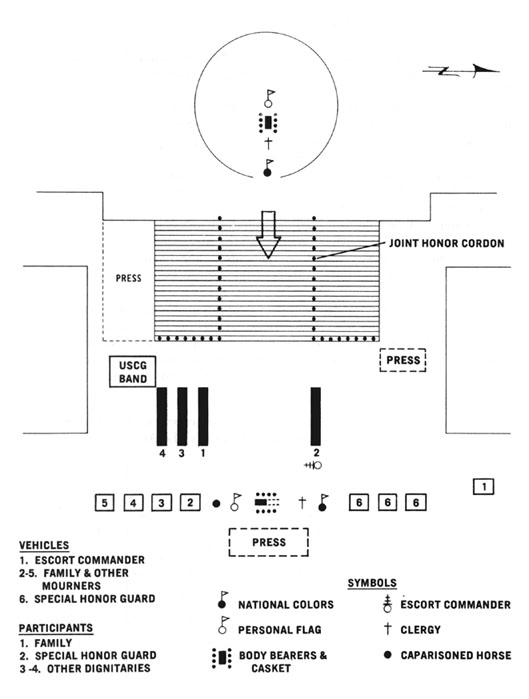
Diagram 73. Departure ceremony at the Capitol.
lined Constitution Avenue from New Jersey Avenue to 14th Street, the
end of the route of the full procession. (Table 23) The procession was
to observe the follow-
[240]
ing order of march: police; escort commander; commander of troops and
his staff; US Army Band; Army, Marine Corps, Navy, Air Force, and Coast
Guard units; special honor guard; national colors; clergy; caisson;
personal flag; caparisoned horse with attendant; family and other mourners;
and police.
When the cortege from the Capitol reached the military units the full
procession marched on Constitution Avenue, members of the street cordon
presenting arms individually as the national color detail approached
and ordering arms as the personal flag bearer passed. Fifty Air Force
planes flew over the column in salute as the procession neared the site
of the casket transfer.
Upon reaching 14th Street the cortege halted so that the caisson was
approximately in the middle of the two blocks of Constitution Avenue
between 12th and 14th Streets. The hearse, which had been parked on
a nearby driveway, was then driven onto the avenue and stopped at the
left of and parallel to the caisson. The escort troops of the cortege
did not pause at 14th Street but marched directly to dismissal points.
Members of the special honor guard meanwhile left their cars and took
their positions near the escort commander for the transfer ceremony.
The MacArthur family and other mourners remained in their cars. (Diagram
74)
While the troops stood at salute, the body bearers transferred the casket
from the caisson to the hearse. The caisson was then driven off the
avenue onto a
TABLE 23-TROOP LIST, PROCESSION FROM THE US CAPITOL
FOR GENERAL OF THE ARMY DOUGLAS MACARTHUR
|
Duty
|
US Army
|
US Marine
Corps
|
US Navy
|
US Air
Force
|
US Coast
Guard
|
Total
|
|
Offi-
cers
|
En-
listed
Men
|
Offi-
cers
|
En-
listed
Men
|
Offi-
cers
|
En-
listed
Men
|
Offi-
cers
|
En-
listed
Men
|
Offi-
cers
|
En-
listed
Men
|
Offi-
cers
|
En-
listed
Men
|
| Escort commander and staff |
1
|
|
|
|
|
|
|
|
|
|
1
|
|
| Special honor guard |
2
|
|
1
|
|
1
|
|
1
|
|
1
|
|
6
|
|
| Commander of troops and staff |
2
|
|
1
|
|
1
|
|
1
|
|
1
|
|
6
|
|
| National color detail |
|
1
|
|
1
|
|
1
|
|
|
|
|
|
3
|
| Clergy |
1
|
|
|
|
|
|
|
|
|
|
1
|
|
| Body bearers |
1
|
2
|
|
2
|
|
2
|
|
2
|
|
2
|
1
|
10
|
| Personal flag bearer (cadet) |
|
1
|
|
|
|
|
|
|
|
|
|
1
|
| Caisson detail |
|
5
|
|
|
|
|
|
|
|
|
|
5
|
| Band |
1
|
82
|
|
|
|
|
|
|
|
|
1
|
82
|
| Military escort, active |
4
|
85
|
4
|
85
|
4
|
85
|
4
|
85
|
4
|
85
|
20
|
425
|
| Street cordon |
|
|
2
|
163
|
2
|
163
|
2
|
163
|
|
|
6
|
489
|
| Site control |
5
|
6
|
|
5
|
|
5
|
1
|
5
|
|
|
6
|
21
|
| Security cordon |
2
|
204
|
|
|
|
|
|
|
|
|
2
|
204
|
| Guides |
|
2
|
|
2
|
|
2
|
|
2
|
|
|
|
8
|
| Total |
19
|
388
|
8
|
258
|
8
|
258
|
9
|
257
|
6
|
87
|
50
|
1,284
|
[241]
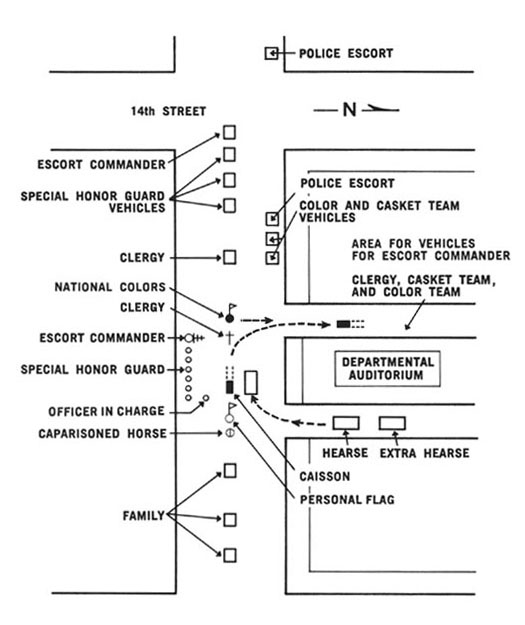
Diagram 74. Ceremony at the transfer of the casket to
the hearse, Washington, DC
nearby roadway. The body bearers, national color detail, and personal
flag bearer boarded two buses and proceeded separately under police
escort to Washington National Airport in order to be in position for
the departure ceremony before the cortege arrived. The escort commander,
clergy, and special honor guard entered
[242]
automobiles and General Wehle moved to the head of the cortege, which
resumed the journey to the airfield. (For route see Diagram 67.)
As the cortege moved over the access road to the Military Air Transport
Service Terminal, members of the joint service cordon which lined the
road presented arms individually when the hearse approached and ordered
arms when it had passed. When the hearse reached the first man of the
cordon, the 3d Infantry battery on the airfield began a 19-gun salute.
(Table 24) The last round was fired as the hearse stopped in
the ceremonial area opposite a waiting C-130 plane. (Diagram 75)
At the same time, President Johnson arrived from the White House by
helicopter to participate in the ceremony. All other vehicles meanwhile
were parked on the ramp behind the ceremonial area, and the occupants
went directly to their assigned positions. A joint service honor cordon
stretched from the hearse to the aircraft and the US Air Force Band
stood nearby. Just outside the ceremonial area was a second plane that
was to take the family and others to Norfolk, Virginia.
After everyone was in position, all troops presented arms, and the Air
Force Band played ruffles and flourishes, the "General's March,"
and "Faith Of Our Fathers." When the hymn began, the body
bearers removed the casket from the
TABLE 24-TROOP LIST, DEPARTURE CEREMONY AT WASHINGTON
NATIONAL AIRPORT FOR GENERAL OF THE ARMY DOUGLAS MACARTHUR
|
Duty
|
US Army
|
US Marine
Corps
|
US Navy
|
US Air
Force
|
US Coast
Guard
|
Total
|
|
Offi-
cers
|
En-
listed
Men
|
Offi-
cers
|
En-
listed
Men
|
Offi-
cers
|
En-
listed
Men
|
Offi-
cers
|
En-
listed
Men
|
Offi-
cers
|
En-
listed
Men
|
Offi-
cers
|
En-
listed
Men
|
| Escort commander and staff |
1
|
|
|
|
|
|
|
|
|
|
1
|
|
| Special honor guard |
2
|
|
1
|
|
1 |
|
1
|
|
1
|
|
6
|
|
| Honor cordon |
1
|
9
|
|
8
|
|
8
|
|
8
|
|
8
|
1
|
41
|
| National color detail |
|
1
|
|
|
|
1
|
|
1
|
|
|
|
3
|
| Body bearers |
1
|
2
|
|
2
|
|
2
|
|
2
|
|
2
|
1
|
10
|
| Personal flag bearer (cadet) |
|
1
|
|
|
|
|
|
|
|
|
|
1
|
| Band |
|
|
|
|
|
|
1
|
54
|
|
|
1
|
54
|
| Street cordon |
|
24
|
|
24
|
|
24
|
|
24
|
|
24
|
|
120
|
| Saluting battery |
1
|
14
|
|
|
|
|
|
|
|
|
1
|
14
|
| Site control |
3
|
|
|
|
|
|
|
|
|
|
3
|
|
| Security cordon |
1
|
78
|
|
|
|
|
|
|
|
|
1
|
78
|
| Floral detail |
1
|
15
|
|
|
|
|
|
|
|
|
1
|
15
|
| Traffic guides |
|
4
|
|
|
|
|
|
|
|
|
|
4
|
| Parking detail |
|
6
|
|
|
|
|
|
|
|
|
|
6
|
| Press cordon |
1
|
10
|
|
|
|
|
|
|
|
|
1
|
10
|
| Baggage detail |
|
10
|
|
|
|
|
|
|
|
|
|
10
|
| Total |
12
|
174
|
1
|
34
|
1
|
35
|
2
|
89
|
1
|
34
|
17
|
366
|
[243]
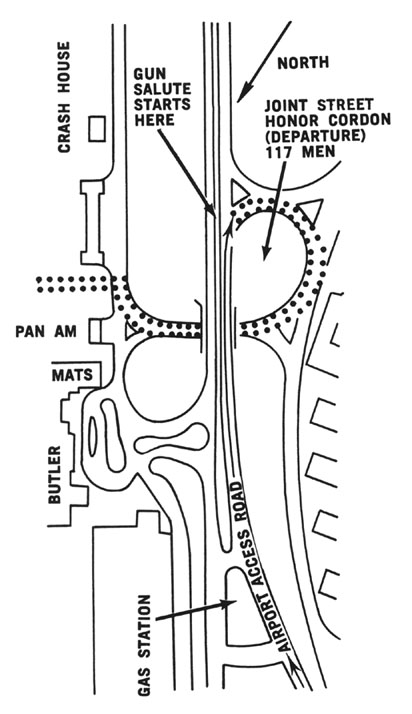
Diagram 75. Street cordon, Washington National Airport.
[244]
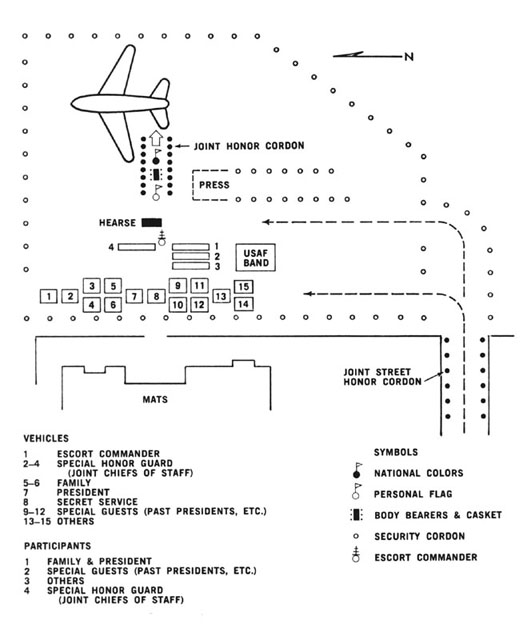
Diagram 76. Departure ceremony, Washington National
Airport.
hearse. In procession, with the national color detail leading, the
casket and the personal flag bearer following, General MacArthur's body
was borne through the honor cordon and placed in the C-130. (Diagram
76) General Whitney followed the personal flag bearer into the aircraft.
After he was aboard the band stopped
[245]
playing and the troops ordered arms and marched away. The C-130 meanwhile
was towed away from the ceremonial area as the second plane was pulled
into its place to take aboard the family and other passengers. President
Johnson escorted Mrs. MacArthur and her son to the plane; the rest of
the group then boarded, and both planes left for Norfolk about 1430.
Events scheduled for 9 April in Norfolk were to begin with the arrival
ceremony at the Norfolk Naval Air Station. A motorized cortege escorting
the hearse was then to proceed via Granby Street and Monticello Avenue
to 21st Street, in the heart of the city, where General MacArthur's
casket was to be transferred to a caisson. A military escort assembled
at the transfer site was to lead the procession to the MacArthur Memorial
near the intersection of City Hall Avenue and Bank Street. In the final
ceremony of the day, the casket was to be placed in the rotunda of the
memorial, where it would remain until 11 April. (Diagram 77)
The two aircraft from Washington reached Norfolk about 1530 on the 9th.
The troops participating in the arrival ceremony, who had taken positions
at the Naval Air Station a half-hour earlier, were the escort commander,
Maj. Gen. Hugh M. Exton of the Continental Army Command staff; a special
honor guard of two general or flag officers from each of the five uniformed
services; a joint service honor cordon, one officer and fifteen enlisted
men, flanking the route from the aircraft to the hearse; a 56-piece
Navy band provided by the Atlantic Fleet; and an Army saluting battery
of one officer and nine enlisted men. Five clergymen were present:
the Reverend Walton W. Davis, rector of St. Paul's Episcopal Church;
the Right Reverend George P. Gunn, bishop of Southern Virginia; the
Right Reverend David S. Rose, bishop coadjutor of Southern Virginia;
the Right Reverend William A. Brown (retired), bishop of Southern Virginia;
and Col. William J. Reiss, chaplain from the Continental Army Command.
Upon landing, the aircraft carrying the family taxied to the ceremonial
area, stopping in line with the honor cordon. Escort officers met the
passengers as they descended and guided them to positions for the ceremony.
The plane then moved away as the C-130 bearing General MacArthur's body,
General Whitney, the body bearers, the national color detail, and the
personal flag bearer taxied into position.
After the rear loading ramp of the C-130 had been lowered, the national
color detail, followed by the body bearers with the casket, marched
part of the way down the ramp and halted. The ceremonial troops presented
arms, the band played ruffles and flourishes and the "General's
March," and the battery fired a 19-gun salute. As the last round
was fired, the band began the hymn "God of Our Fathers." In
procession, the national color detail and clergymen leading, the casket
and the personal flag bearer following, General MacArthur's casket was
carried through the honor cordon and placed in the hearse. (Diagram
78) The ceremony concluded, escort officers guided the family group
and special honor guard to waiting cars, and the cortege formed for
the journey to the casket trans-
[246]
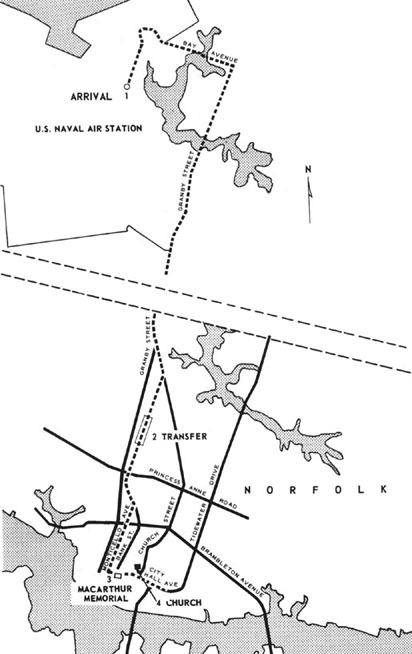
Diagram 77. Ceremonial sites, Norfolk, Virginia.
[247]
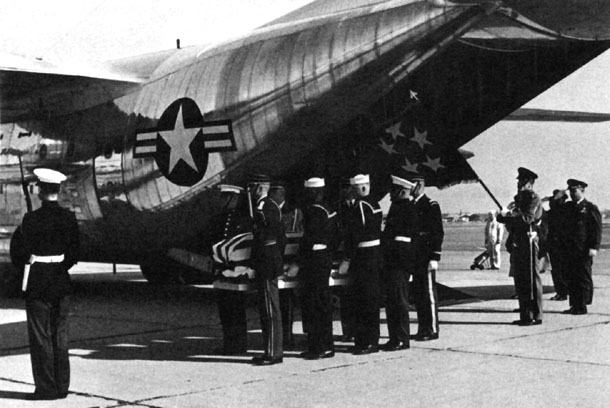
CASKET IS CARRIED FROM PLANE AT NAVAL AIR STATION, NORFOLK,
VIRGINIA, above.
Cortege leaves the Naval Air Station, below.
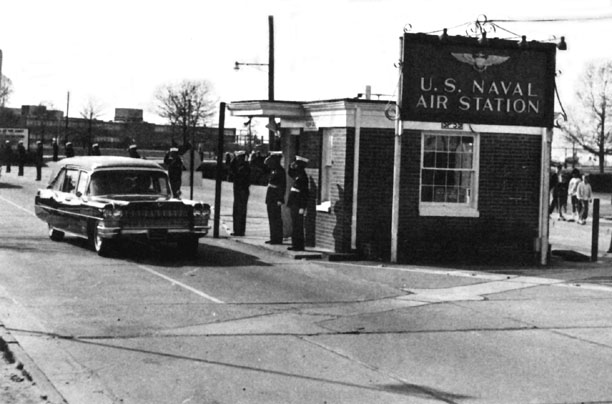
[248]

Diagram 78. Arrival ceremony, Norfolk Naval Air Station.
fer site. The body bearers and color bearers meanwhile entered other
vehicles and left the field immediately in order to reach the transfer
site ahead of the cortege. The military escort troops waited in column
on Monticello Avenue below 21st
[249]
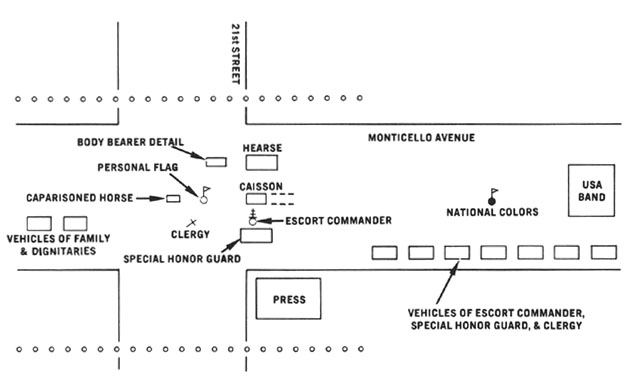
Diagram 79. Casket transfer ceremony, Norfolk.
Street in the prescribed order of march: the escort commander's staff;
a drum corps of twenty drummers selected from bands in the Second Army
area; the Army commander of troops and his joint service staff of five;
a company of eighty-nine cadets from the US Military Academy; a company
of four officers and eighty-five enlisted men each from the Army (Fort
Eustis), Marine Corps (Atlantic Fleet), Navy (Atlantic Fleet), Air Force
(Tactical Air Command), and Coast Guard (Atlantic Fleet) ; and a special
Army band of seventy musicians selected from the Continental Army Command
and Second Army Bands.
Behind the military escort at 21st Street and in the center of Monticello
Avenue stood the caisson, and to its rear were the caparisoned horse
and its handler sent down by the Military District of Washington. When
the body and color bearers from the airfield reached the site, the national
color detail took its position for the transfer ceremony ahead of and
facing the caisson. The personal flag bearer stationed himself behind
the caisson while the body bearers waited to one side.
On either side of the transfer site, a security cordon of one officer
and sixtythree enlisted men was in position to keep the ceremonial
area clear. At first the men in the cordon stood on the curb facing
the street in the manner of a street honor cordon. With their backs
to the spectators and lacking restraining ropes, the troops were having
trouble keeping the public out of the ceremonial area. Before the cortege
arrived, however, the site control officer rearranged the cordon, placing
the troops in the street just off the curb and having them face the
spectators.
[250]

PROCESSION MOVES THROUGH NORFOLK TO MACARTHUR MEMORIAL
As the cortege halted at the transfer site, the commander of troops
called the escort troops to attention. The escort commander, special
honor guard, and clergy left their cars and took their places for the
ceremony; members of the family remained in their cars. The hearse meantime
had been driven to a position left of and parallel to the caisson. (Diagram
79) At a signal from the site control officer, the body bearers
went to the hearse where they secured the casket and placed it on the
caisson. General Exton then walked to the head of the military escort
to lead the procession. At the same time, the members of the special
honor guard took their positions ahead of the national color detail,
which turned about in preparation for the march. Those of the clergy
who were to go on foot took their places behind the colors and in front
of the caisson while the others reentered their cars. General Exton,
at a signal from the site control officer, led the procession forward.
The column moved along Monticello Avenue as far as City Hall Avenue,
turned left, and proceeded to the MacArthur Memorial. (See Diagram
77.)
Upon reaching the memorial, General Exton and his staff and the special
honor guard moved to the west entrance; the drum corps and the escort
troops
[251]
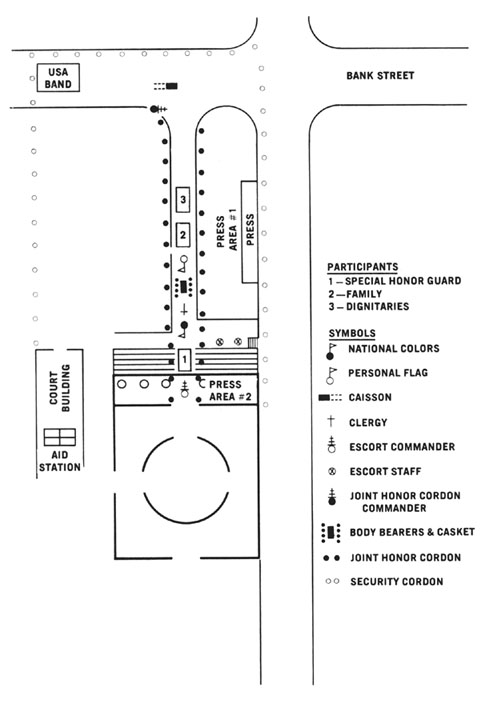
Diagram 80. Arrival ceremony, MacArthur Memorial, Norfolk.
[252]
continued along City Hall Avenue to dismissal points. The band and
the cortege turned right onto Bank Street and halted, the caisson drawn
up at the end of a long walkway which led from Bank Street to the west
entrance of the memorial. The walkway was lined on both sides by a joint
service honor cordon consisting of one Army officer and eight enlisted
men from each of the five uniformed services.
Escort officers helped the family and other mourners from their cars
and guided them to their appointed positions for the ceremony. The honor
cordon then presented arms and the band played ruffles and flourishes,
the "General's March," and "Abide with Me." As the
hymn began, the body bearers removed the casket from the caisson and
in procession it was carried into the memorial. (Diagram 80)
The memorial building itself had once been the Norfolk courthouse, begun
in 1847 and completed in 1850. The consulting architect was Thomas V.
Walter of Philadelphia, designer of the dome and the House and Senate
wings of the Capitol in Washington. In 1960 the mayor of Norfolk proposed
remodeling the courthouse, using funds raised by public contribution,
as a memorial to General MacArthur and as a repository for his papers,
decorations, and mementos. General MacArthur accepted. Although he had
no other ties with the state, his mother was a Virginian, born in Norfolk.
Restored and remodeled, the building contains nine museum galleries
whose contents reflect the general's fifty years of military service.
At the heart of the memorial is a rotunda, and in its center a circular
sunken crypt holding two marble sarcophagi, one for General MacArthur,
the other for his wife.
As the cortege entered the rotunda, the body bearers placed the casket
on a catafalque erected over the crypt. When the other members of the
procession were in position around the catafalque, the first relief
of an honor guard, furnished by the Military District of Washington,
took post at the bier and the body bearers were dismissed. (Diagram
81) The mayor of Norfolk, in behalf of the people of the city, laid
a wreath at the bier. Everyone then left the rotunda except the family,
the clergy, and the mortician, who departed after the family approved
the arrangements in the rotunda.
The memorial was open to the public from 1800 on 9 April until 0700
on the 11th. During that time, about 62,000 people filed through the
rotunda to pay their respects, entering by the west door and leaving
by the south door.
On the morning of 11 April, troops that were to participate in the ceremonies
were in their positions by 0915. General Exton and the special honor
guard stationed themselves just outside the west entrance of the memorial
while the body bearers, national color detail, personal flag bearer,
and clergy assembled in the rotunda. Lining the walkway to the caisson
on Bank Street was a joint service honor cordon of one officer and forty-two
enlisted men. The composite Army band was in formation on City Hall
Avenue just below the Bank Street intersection. On the grounds north
of the band stood the Army saluting battery which would not par-
[253]
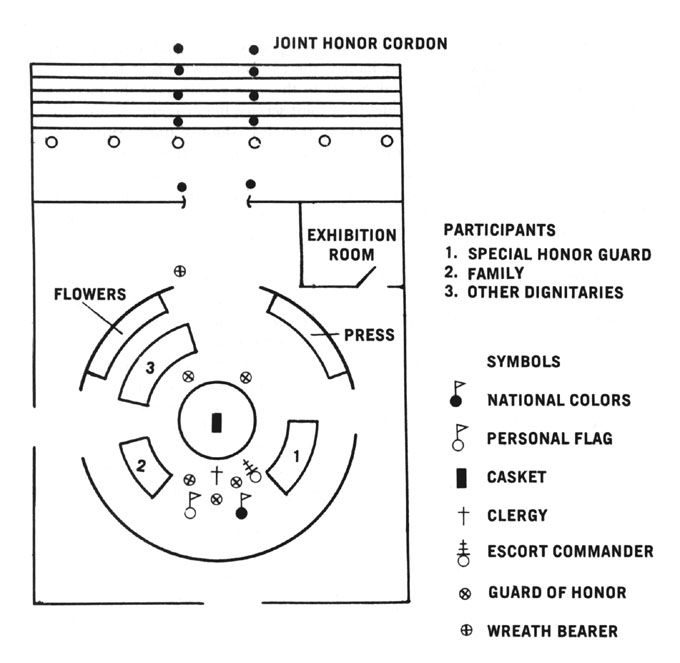
Diagram 81. Formation, rotunda of MacArthur Memorial,
Norfolk.
ticipate until the procession returned to the memorial after the service
at St. Paul's Episcopal Church. Lining both sides of City Hall Avenue
from the MacArthur Memorial to the church were eighty troops-twenty
each from the Army, Marine Corps, Navy, and Air Force-bearing the flags
of the United Nations, all states and territories except the District
of Columbia, and the twenty-eight military commands in which the general
had served. (Diagram 82)
The MacArthur family and other mourners arrived in the rotunda of the
memorial at 0920; ten minutes later the ceremony began. General Exton
and the special honor guard moved onto the walkway outside the west
entrance. The national color detail then led the way out of the rotunda,
followed by the clergy, the
[254]
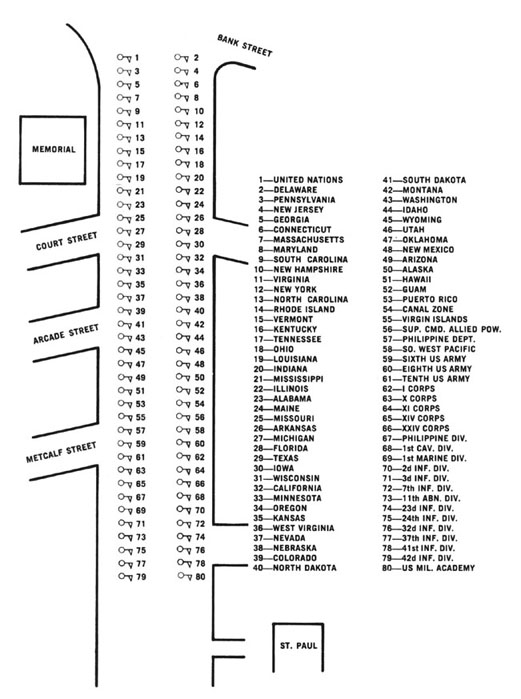
Diagram 82. Flag cordon, Norfolk.
[255]

Diagram 83. Departure ceremony, MacArthur Memorial,
Norfolk.
[256]
body bearers with the casket, the personal flag bearer, the family, and
other mourners. When the national color detail reached the west entrance
it halted; the honor cordon presented arms and the band played ruffles
and flourishes and the "General's March." As the band began
the hymn "God of Our Fathers," the procession moved down the
walkway to Bank Street where the body bearers secured the casket to the
caisson. (Diagram 83) Other members took their places and the march
to the church began.
As the procession passed through the cordon of flags, the flag bearers,
facing each other across the street, dipped their flags in pans as the
national color detail approached and held the salute until the personal
flag bearer had passed. When the head of the cortege reached the south
gate of the churchyard on City Hall Avenue, General Exton turned in while
his staff and the band continued to the intersection of the avenue with
St. Paul Boulevard, where they turned and halted. (Diagram 84)
The special honor guard followed General Exton through the church gate
and half the distance from the gate to the church, where they placed themselves
along the edge of the walk, five on each side. The national color detail
and the clergy also entered and halted just inside the gate. The caisson
and personal flag bearer meanwhile had stopped on the avenue opposite
the gate.
When the family and other mourners reached the gate, they were escorted
down the walkway and into the church where some 400 invited guests were
already seated. These included officials of the federal, state, and local
governments, members of the diplomatic corps, foreign dignitaries, and
a large number of military men from all of the armed forces. Attorney
General and Mrs. Robert F. Kennedy attended as the representatives of
President Johnson.
After the family had been ushered into the church the band, at a signal
from the site control officer, played ruffles and flourishes and the "General's
March." At the first note, the escort commander, special honor guard,
body bearers, and color bearers presented arms; they held the salute until
the march was over. When the band began "Rock of Ages," the
body bearers lifted the casket from the caisson. Led by General Exton,
the procession of special honor guard, national color detail, clergy,
body bearers with the casket, and personal flag bearer entered the church.
Just inside the door the body bearers placed the casket on a movable bier.
Preceded by the Reverend Walton W. Davis, rector of St. Paul's, two of
the bearers wheeled the casket to the front of the church, then retired.
The colors were posted in the church foyer.
The Reverend Mr. Davis, assisted by the Right Reverend George P. Gunn,
bishop of Southern Virginia, conducted a brief religious service. At the
conclusion two body bearers went forward to the casket. The clergymen
leading, the family group following, the casket was wheeled to the church
entrance. General Exton, the special honor guard, and the national color
detail meanwhile left the church and took their places on the sidewalk
for the departure ceremony.
When all the body bearers had taken their positions around the casket
at the
[257]

CAISSON HALTS OUTSIDE ST. PAUL'S EPISCOPAL CHURCH, NORFOLK, above.
Casket is moved to front of St. Paul's Episcopal Church, below.
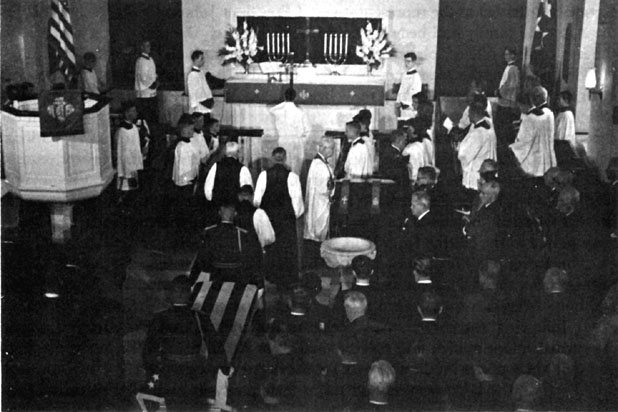
[258]
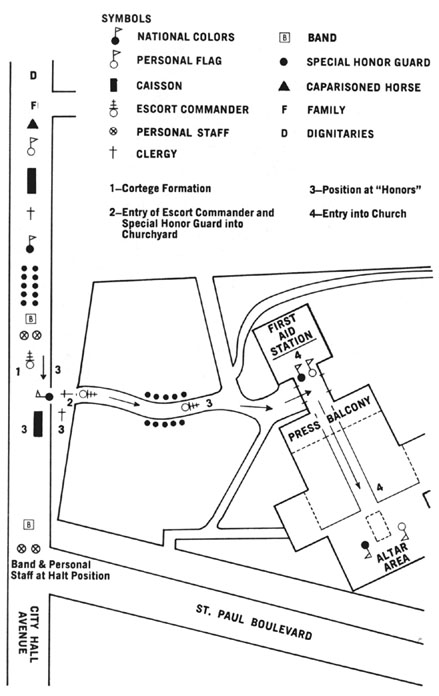
Diagram 84. Arrival at St. Paul's Episcopal Church,
Norfolk.
[259]
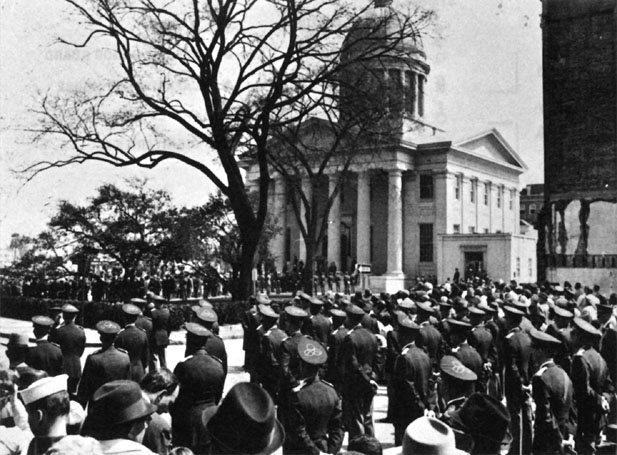
TROOPS FORM OUTSIDE MACARTHUR MEMORIAL FOR LAST RITES
church entrance, the band again sounded ruffles and flourishes and played
the "General's March." As it began the hymn "Lead Kindly
Light," General Exton led the procession from the church. Behind
the general came the national color detail, clergy, body bearers with
the casket, personal flag bearer, family, and other mourners. At City
Hall Avenue the casket was secured to the caisson, which had been turned
around during the funeral service for the return trip to the MacArthur
Memorial. In the same order as before the procession marched along City
Hall Avenue.
The members of the flag cordon again dipped their flags in salute. At
the MacArthur Memorial, the participants took the same positions they
had occupied during the arrival ceremony on 9 April. An Army firing
squad had been added to the troop formations and stood on the memorial
grounds near the west entrance. Following the same procedure as on the
9th, General MacArthur's body was then taken in procession to the rotunda.
(Diagram 85)
Bishop Gunn conducted a brief service in the rotunda. At its conclusion
the honor cordon outside the memorial presented arms, the battery on
the grounds north of City Hall Avenue began a 19-gun salute, and the
members of the flag
[260]
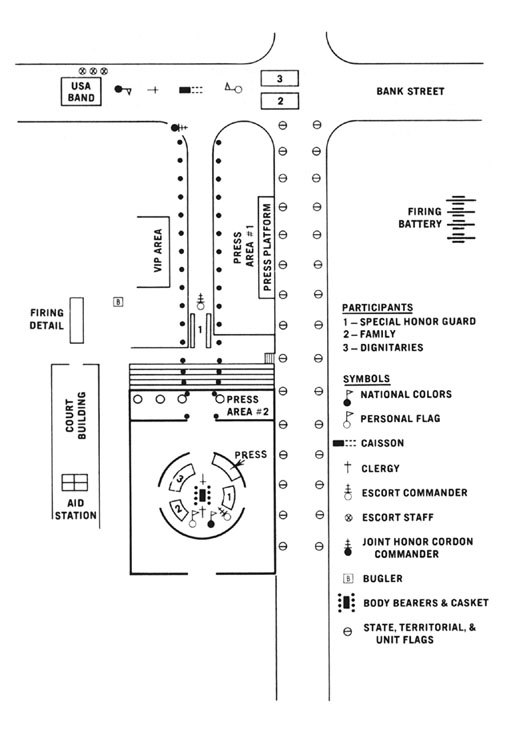
Diagram 85. Arrival and burial ceremonies, MacArthur
Memorial, Norfolk.
[261]
cordon along the avenue dipped their colors. When the last round of
the gun salute had been fired, Bishop Gunn pronounced the benediction.
The traditional three volleys were then discharged by the firing party
and the bugler from the band sounded taps. The body bearers folded the
flag that had draped the casket and handed it to General Exton who presented
it to Mrs. MacArthur.
After the ceremony, about noon, the MacArthur family group was flown
back to New York City. The period of national mourning for General MacArthur
ended at sunset on 11 April when a battery at Fort Monroe, across Hampton
Roads from Norfolk, fired a final 19-gun salute.
[262]
Previous Chapter
Next Chapter
|




































